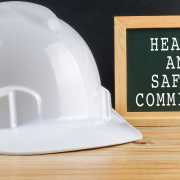
Learn about some of the different types of liabilities businesses face, and what to do if OSHA shows up at your door.
Transcription:
Today I want to talk a little bit about OSHA. Our friends at the Occupational Safety and Health Administration.
There are a couple of jokes that have been floating around for a hundred years. That show a fellow looking out of the office window as he sees a gentleman climbing out of a car that says OSHA on the side of it. And the little cartoon bubble above the head of the OSHA guy says OSHA—Our savior has arrived. And it shows the company owner looking out the window saying oh something different–him again. The implication is that everybody hates to see OSHA coming through the door.
So, I want to talk about a couple of things—first of all, we get asked all the time about the actual liability that a company possesses relative to worker health and safety. And I always say you have two different types of liability. You got the liability of an OSHA inspection and if you’re non-compliant any incumbent penalties that would accompany that inspection and then also the abatement time that it would take to fix things that they pull up as a result of that inspection.
That could be no money, thousands and thousands and thousands of dollars—an inspection could take a couple of hours, it could take several weeks.
We always say it’s more disruptive to the operation of a business than it is punitive in nature. The other liability the company possesses relative to worker health and safety is the fact that somebody is actually going to get hurt on the job. If you have your best production person, your best manager, your best whatever, and they actually are hurt to the point that they can’t come to work your business suffers way more from that injury than it ever would from an OSHA inspection.
There’s an old insurance industry saying that basically says for every dollar that you spend on indirect costs on an accident that happens on the job you spend about seven dollars in indirect costs. So, if a hospital bill is a thousand dollars expect that you spent another seven thousand dollars on lost time, retraining somebody, overtime pay, and a whole bunch of other things. The new model in a world economy says that for every dollar of indirect costs you spend something north of 30 dollars on indirect costs.
So, if that same claim now costs you a thousand dollars. Those indirect costs cost you thirty thousand dollars and it gets into everything from the standpoint of who wants to work for a company where people get hurt, so you can’t attract the best employees, you can’t keep good employees because if there are people getting injured they see that as a downside to their employment. If you have employees getting hurt, you have lost opportunity cost in a worldwide economy. You have an inability to grow your company and maybe respond to international business.
So the whole bottom line here is we always counsel people to say between the two liabilities the bigger liability you always have is of actually hurting somebody because it affects morale, there are costs associated with it, and frankly, nobody wants to work for a company where people are getting hurt. Having said that I want to talk a little bit about OSHA and an OSHA inspection.
The majority of the inspections that OSHA conducts are actually the result of an employee complaint. Or an actual injury. There are certain circumstances under which you’re supposed to report injuries to OSHA but there are also some cooperative operations between law enforcement personnel, emergency responders, and even hospitals where they will report to OSHA if somebody has been injured on the job and transported to a hospital or a medical treatment facility.
And that can result in an inspection for that specific accident that happened. There are somewhat they call special emphasis programs where they pick out targeted industries that have lots of injuries for inspection but by and large, I believe that the still the majority of the inspections that they conduct are based on employee complaints.
Having said that what we always caution people to do that if you have employees who are complaining about safety, whether it’s indoor air quality, noise, chemical exposure, unsafe machinery, forklifts with no brakes, exits that are blocked or locked it’s way best to respond to those complaints and do that and address those concerns through your safety committee and your safety program as opposed to waiting until somebody gets annoyed enough to actually file a complaint and then you get into the which is the greater liability.
Once OSHA comes through your door you may end up with a protracted inspection with a lot of costs just from the inspection process itself. But then you have the specter of ending up with penalties and abatement dates and a whole cascade of other events that are going to happen. So, what do you do If OSHA knocks on your door? Now there are some really basic things that we talk about. We have some seminars that we teach on this but we differ in some cases and some of the legal opinions on this to the folks who show up at your door and need to or want to come in and look at something you’re always the way, way better off to allow them to come in.
We’ve talked to some people who make them get a search warrant or deny them entry so that they are forced to go get a search warrant and those inspections almost never go well. OSHA then assumes you’re hiding something. So, when they come back, they’ve got both barrels loaded and they’re looking for something to be wrong as opposed to coming in to look at what they’re looking for in the first place. There are some basics in terms of what OSHA’s supposed to do that you should look out for when they come into your facility.
They are supposed to present their credentials. They all carry a badge just like the old FBI series with Efrem Zimbalist. They’ve got a thing they pull out of their pocket that’s got a picture that identifies them as an OSHA inspector. They are supposed to present their credentials. They are supposed to ask for a senior management official. They can’t come in and grab whoever is at the reception desk and say come on we’re going to go do an inspection. They have to have what’s called an opening conference where they’re supposed to sit down and tell you why they’re there. The nature of their visit, whether it’s a complaint, whether it’s a general schedule inspection, and so forth.
And if it’s a complaint inspection they’re going to provide you a copy of the employee complaint and it will not have the name of the employee on it, obviously. They get very annoyed if you try to find out who filed a complaint, and if you were ever to take any kind of action against that employee there are some pretty severe penalties and even some civil penalties for doing that.
So, what we suggest is to allow them in, take good notes, and document what they’re doing and what they don’t do. They are allowed to pull people aside and have interviews with them and allow them to do that, providing them with a quiet space to do that. They will ask if you have a labor organization or a union present and they will ask for union representation during the inspection. We suggest you go along with that as well.
And in terms of them conducting their inspection pretty much give them free rein to look at what they want to look at with some common sense involved. If they’re there to do a complaint inspection and look at a specific piece of machinery equipment, then make a direct path to that piece of equipment or machinery and try to minimize what else they might be stopping to look at.
If they start to wander and want to go look at other pieces of equipment, machinery, people, operations, whatever, remind them that they’re there to conduct a complaint inspection and try to redirect them back to the purpose of their visit. Again, they can kind of do what they want to do within limits. So, take good notes, and make sure that you stay on top of what they’re supposed to do because you ultimately will have your day in court so to speak.
At the end of their inspection, they’re required to have what they call a closing conference where they’re supposed to sit down with you. And once in a while it’s done by phone but in most cases, it’s done in person and they’ll tell you what they looked at, what they inspected for, they will tell you the items that they think they’re going to site you for because it has to be signed off on at the area office and not necessarily by the person doing the inspection.
And then they will talk about what it’s going to take you to fix the things that they are citing you for. I have a whole other conversation on that which I’ll talk about in a different podcast but in this particular case make note of what they’re talking about. If they want, you to install or build something that you know it’s going to take you five weeks to order it and get it. And then another five weeks to install and operate it. Then if they start discussing abatement dates with you don’t ever agree to an abatement date that’s two or three weeks when you know that it’s going to already take 10 to 12 weeks to get the thing purchased and installed.
So that’s a time to have a negotiation with them. They will then issue you a citation as a formal document. And what we say is it’s a living or a dynamic document at that point. It’s a citation that is not cast in concrete and you get to have your day in court by requesting what’s called an informal conference with the area director where you can go in and refute the contest or argue about whatever is on that citation, and up until the point that the area director and or you sign off on that citation, it does not exist.
So, you get the right to go in within 15 business days to have a conversation with the area director. It’s called an informal conference. You should request it over the phone and then follow it up in writing to make sure there’s a paper trail. We always suggest you do it as early in that 15-day period as possible. So that just in case you need to do other things or engage an attorney to contest the citation you have plenty of time to do it. Don’t wait until the 14th or 15th day to do it because there’s just not enough time to make it work.
In that meeting, you can discuss any part of the citation, if you disagree with what they cited you for if you disagree with the number of penalties that they may have assessed you if you disagree with the abatement date that they give you, all that is open for conversation and in a lot of cases we refer to it as let’s make a deal because the area directors primary goal is to get the citation to stick. In other words, they don’t want compromise items that they’ve cited you for.
So, they can wheel and deal a little bit with penalties over the years that whole penalty structure thing has changed. We say if you can get them to reduce the penalty by 50 percent or greater, you’re doing pretty well. And then a lot of cases if you find things, you’re citing you for that you absolutely agree with. You’re far better off to have fixed it already or suggest that you’re more than willing to fix it and try to negotiate the penalty down and then you can use penalties to help pay for the fixes that you have to put in place.
If you can’t come to an agreement with the area director then your last resort if you will is to contest the citation you should do this in writing within that 15-day period and you can be contested on any grounds or no grounds at all. You can say I can test the entire citation, the penalties, the abatement dates, whatever it is you can contest, and at that point, it then leaves the area director’s hands and the local offices’ hands and it goes to the regional office where it’s handled by the regional solicitors.
And then it becomes basically a legal case where you’ll get up in front of an administrative law judge and you get to plead your case. In my history of doing this, I haven’t seen a ton of these cases that make it that far because generally you can work it out with the area director as long as you’re being reasonable and they’re being reasonable. But we always suggest that you try to resolve the issue at the local area office before it gets into a major deal at the regional office with lawyers involved in the cost of attorneys and a whole bunch of other stuff.
The other thing we would caution people against is OSHA has recently in the last several years come up with a settlement agreement that is more or less a canned agreement where they will give in on some of the penalties or some of the items that they’ve cited you for. But then they have this kind of generic settlement agreement, and in there you end up not knowing that you are agreeing to conduct comprehensive safety audits or implement safety policies and programs because it’s not obvious that it’s in there in writing.
So we would suggest if they give you anything to sign you don’t sign it in a hurry because you think you’re getting a discount on penalties when all of a sudden you’re obligating yourself to a whole bunch of other things that you might not want to obligate yourself to. I guess the last factoid on that is if you’ve got an attorney, we find that a lot of attorneys don’t have much OSHA experience.
So you’re far better off if you need to or feel like you want to engage an attorney to try to find somebody that has a significant amount of OSHA experience because it’s not something that your real estate or business lawyer typically has a lot of expertise in and they can’t give you very good advice about how to handle it.
If you have any questions relative to OSHA inspections or compliance or need any help with inspections or with the results of an inspection feel free to contact us.





